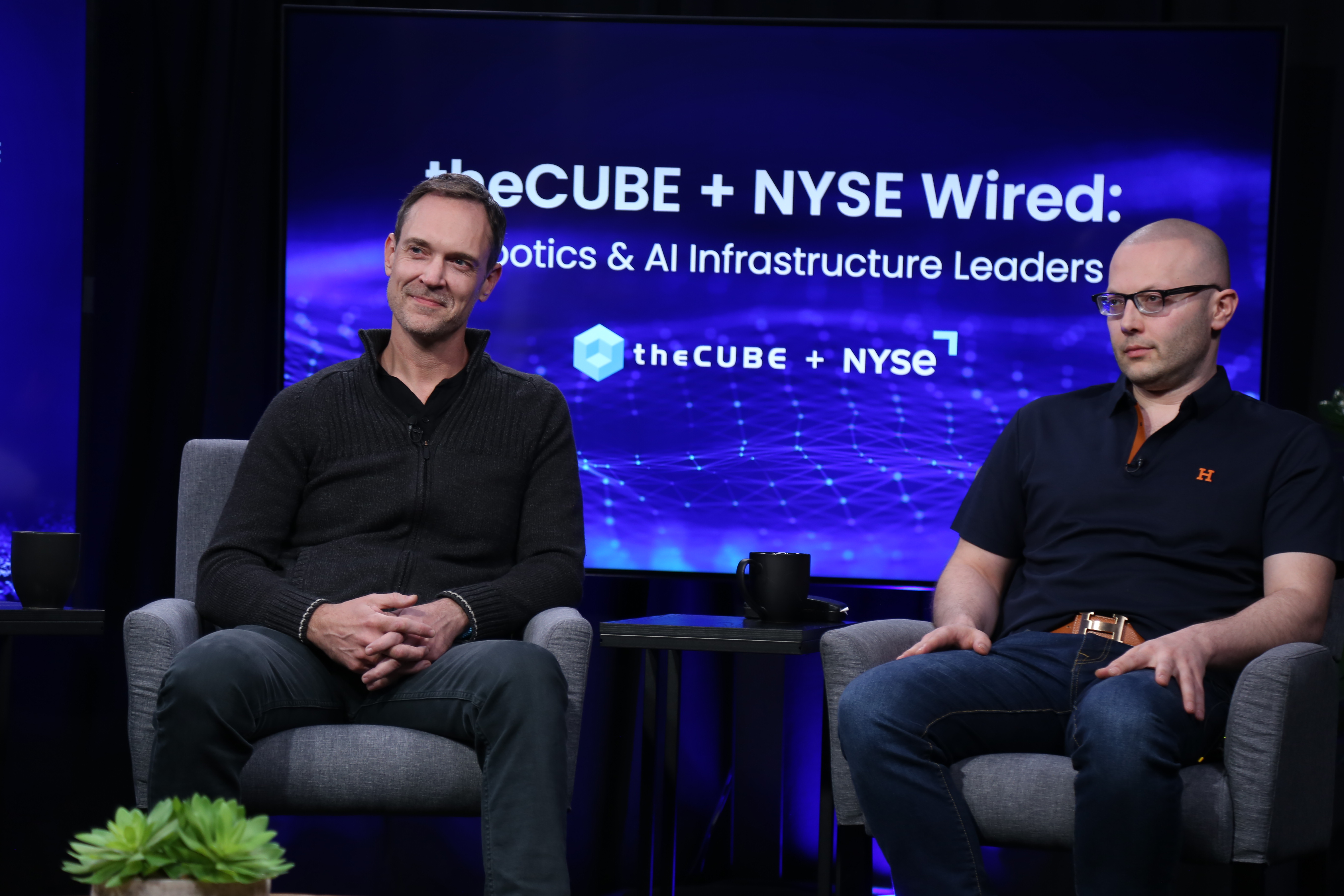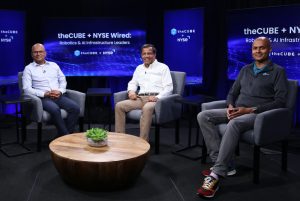 AI
AI
Tracking the AI infrastructure boom: 10 ways large-scale infrastructure is reshaping AI’s future

Artificial intelligence’s next leap starts with large-scale infrastructure — and the world is racing to build it.
A surge of investment in large-scale infrastructure is redrawing the global tech map, as enterprises and governments pour billions into the backbone needed for next-generation AI. From sovereign data centers to foundational model training, what’s emerging is a distributed, adaptive and deeply human-centric system built to meet AI’s exponential demands, according to John Furrier, executive analyst at theCUBE Research.

Cerebras’ Andy Hock, HUMAIN’s Shehram Jamal, Vultr’s Kevin Cochrane and NativelyAI’s Joseph Spence talk to theCUBE’s John Furrier about large-scale infrastructure.
“We are seeing a demand for large-scale infrastructure because the demand for tokens that’s powering the software requires large-scale system reconfigurations, rethinking around the size and scope for what’s needed, but also to set the table for a generation of infrastructure that will power the wave of AI and certainly we’ve seen the agentic world come in,” Furrier said.
Furrier and fellow analyst Dave Vellante were joined by top minds shaping the next generation of intelligent systems and silicon innovation during “theCUBE + NYSE Wired Robotics & AI Infrastructure Leaders” event. They explored how large-scale infrastructure is driving the next phase of AI, from sovereign compute and startup disruption to developer roles and data architecture evolution.
1. How large-scale infrastructure is redefining AI’s global potential
Infrastructure is no longer just about hardware — it’s the connective tissue for AI ecosystems. Furrier was joined by a group of panelists as they talked about how distributed computing must enable local innovation, sovereign AI and regional model development. Kevin Cochrane , chief marketing officer of Vultr, a registered trademark of The Constant Company LLC, pointed out the urgency of democratizing infrastructure to lift digital economies, while Shehram Jamal (pictured, right), chief product officer for data & models at HUMAIN (Al-Mustaqbal Lil-Thaka Al-Istinai Company, also known as Future Artificial Intelligence Company), likened sovereign AI to a nation’s power grid: essential, not optional.
Andy Hock (left), senior vice president of product and strategy at Cerebras Systems Inc., added that access to high-performance compute changes the game entirely — transforming AI from a luxury of a few to a tool for all. With models growing more efficient and accessible, even emerging markets are finding new paths to participate in AI’s evolution. If this global buildout continues at pace, infrastructure may become the great equalizer in the digital age.
Read more on theCUBE.
2. Where VC bets are shifting in the AI era
Venture capital is undergoing a generational reset as large-scale infrastructure investments give rise to radically new startup dynamics. Infrastructure advances are slashing barriers to entry, enabling smaller, faster and often younger teams to compete — and sometimes outpace — the legacy giants in AI’s new playbook, according to Aileen Lee, founder and managing partner at Cowboy Capital LLC (dba Cowboy Ventures); Lake Dai, founder and managing partner at Sancus Ventures; and Sue Xu, managing partner at Amino Capital.
The panel agreed that startups today can hit meaningful revenue milestones with just a few engineers and a well-optimized agentic stack. This shift isn’t just technical — it’s cultural. Founders without legacy baggage, including high schoolers and college students, are reimagining enterprise workflows and user experiences at speed, attracting serious investment in both application and infrastructure layers.
Check out theCUBE’s complete interview.
3. How SambaNova is redefining enterprise AI infrastructure
Rodrigo Liang, chief executive officer of SambaNova Systems Inc., laid out a pragmatic roadmap for enterprise AI adoption that hinges on one critical factor: energy efficiency. As demand surges for agentic systems and advanced reasoning models, enterprises face an infrastructure bottleneck — not just in compute capacity, but in power consumption. Large-scale infrastructure must evolve to meet this demand without overhauling entire data centers.
SambaNova’s solution? Rack-based, air-cooled systems that slot directly into existing enterprise environments, cutting deployment time and slashing energy use. Liang emphasized that inferencing — not training — will dominate AI workloads going forward. That shift is driving a wave of on-prem builds as enterprises seek secure, sovereign AI deployments with rapid time to value.
For the full interview, check out theCUBE’s coverage.
4. The new shape of AI architecture: How storage, compute and data models are converging

Neo4j’s Philip Rathle speaks to theCUBE about composable data infrastructure.
The foundation of large-scale infrastructure is rapidly evolving as storage and compute become decoupled and modularized, setting the stage for more agile, data-driven AI architectures. Cloud-native design patterns — particularly object storage layered with specialized query engines — are reshaping database roles from rigid systems into composable services, according to Nikita Shamgunov, CEO of Neon Inc.; Tanya Bragin, VP of product at ClickHouse Inc.; and Philip Rathle, chief technology officer of Neo4j Inc. The result is faster, more scalable systems that adapt to a wide range of workloads across OLTP, analytics and observability.
What was once siloed is becoming a unified, multi-layered ecosystem. Transactional engines now interface directly with real-time analytics systems, while graph databases fill the gaps by modeling connections between people, processes and knowledge. As application and data needs grow increasingly dynamic, this convergence is not just technical — it’s strategic. These next-gen systems are designed to scale efficiently, reduce environmental cost and serve AI agents in real time, without forcing a tradeoff between flexibility and governance.
Check out the full story on theCUBE.
5. From coder to curator: How agents are reshaping software engineering roles
For developers, the shift to agent-based coding means less typing and more strategic supervision. AI tools are now capable of handling the bulk of code generation — freeing engineers to focus on architectural choices, security implications and long-term maintainability, according to Guy Gur-Ari, co-founder of Augment Code. Instead of line-by-line craftsmanship, the job becomes tech lead for a team of agents.
This evolution is rapidly changing the skills developers need. Reviewing, guiding and managing output from multiple agents at once has become a core part of the workflow. As companies adopt large-scale infrastructure to support these tools, productivity gains are accelerating — but only for teams ready to adapt. Gur-Ari emphasized that the future belongs to those who learn how to work with agents, not just beside them.
Don’t miss the full interview on theCUBE.
6. Rethinking AI infrastructure for public and private sector leadership
Public sector transformation is hitting an inflection point as nations race to establish sovereign cloud infrastructure and onshore chip manufacturing. The AI value chain — from optics to silicon to software — is reshaping global priorities in infrastructure strategy, according to Diane Bryant, independent director for Broadcom Inc., Celestial AI Inc., Haemonetics Corp. and mmTron Inc.
From her vantage point across enterprise, startup and government-facing boards, Bryant sees compute capacity, data movement and power efficiency as the core forces shaping future innovation. The lesson from her decades at Intel, from 1998 to 2017? Transformation takes time — often a full decade. And with AI, that long cycle has finally tipped into mass adoption, creating new opportunities for leadership across both industry and government.
Check out theCUBE’s complete interview.
7. Why AI agents demand a rethink of developer roles and enterprise workflows

San Francisco AI Factory’s Matan Grinberg and Gen Digital’s Howie Xu discusses AI-native development with theCUBE.
Software engineers are no longer just coders — they’re becoming orchestrators of intelligent systems. Matan Grinberg, CEO of The San Francisco AI Factory Inc. (doing business as Factory), and Howie Xu, chief AI and innovative officer at Gen Digital Inc., talked about how modern engineering excellence lies in systems thinking, not syntax. With agentic tools such as Factory’s “droids” taking over mundane tasks such as migrations, testing and documentation, developers are free to focus on architecture, planning and business alignment — where their true value lies.
This behavior shift isn’t automatic. Enterprises need intentional change management to unlock the benefits of AI-native development. The most successful teams adopt a mindset of adaptability, regularly revisiting workflows to accommodate new tools and capabilities, according to Grinberg. With agentic systems maturing fast and demand for large-scale infrastructure growing alongside, companies that prioritize governance, developer enablement and workflow redesign will be best positioned to lead in the AI-powered enterprise era.
Watch the full interview from theCUBE.
8. Edge innovation meets AI infrastructure: Unlocking smarter cities and systems
High-performance, low-power compute is reshaping how edge devices process, analyze and respond to data — right where it’s created. This evolution is key to enabling real-time robotics, adaptive surveillance and intelligent transportation systems. It also lays the groundwork for public sector transformation, particularly in areas such as smart cities and defense infrastructure, according to Vijay Nagarajan, VP of strategy and marketing at Broadcom Inc.; Harminder Sehmi, chief financial officer of Blaize Inc.; and Gopal Hegde, SVP of engineering at SiMa Technologies Inc.
By moving compute closer to the source, organizations are reducing latency, lowering power consumption and safeguarding data privacy. From lamppost cameras to industrial drones, the trio of experts emphasized that hardware-software co-design, edge-first architectures and open standards are critical to scaling innovation across geographies and industries. This dynamic edge-to-cloud continuum is redefining how intelligent systems are built, deployed and governed.
Watch theCUBE’s full sit-down.
9. The data OS for agents: Why Vast Data is rethinking infrastructure from the ground up
As enterprises shift from analytics to agent-driven intelligence, Renen Hallak, founder and CEO of Vast Data, sees a major inflection point in how infrastructure is built and used. Large-scale infrastructure is no longer just about storage speed or capacity — it must support persistent memory, observability and fine-grained access across agents with unique models and data needs. Hallak believes the next phase of enterprise AI will require an operating system that can coordinate these intelligent entities, not just serve up rows and dashboards.
This vision places data at the center of the AI value chain. Unlike traditional analytics platforms focused on structured data and retrospective queries, Vast is building a new kind of data engine — one optimized for inference, vector search and unstructured formats. The rise of reasoning models, agent-to-agent communication and the need for secure, governed access are pushing infrastructure to evolve beyond legacy paradigms. In this new world, Hallak argues, the data layer must be intelligent, real-time and foundational to AI operations.
Check out theCUBE’s complete interview.
10. How AI is reshaping the data center for public and private innovation

Aviz Networks’ Vishal Shukla, Arrcus’ Shekar Ayyar and Cisco’s Anand Raghavan talk to theCUBE about AI-ready infrastructure.
Rethinking the data center is now a prerequisite for scaling AI efficiently — and it’s networking that’s setting the pace. From managing inference workloads to supporting agentic systems, AI-ready infrastructure needs both speed and adaptability. That’s fueling public sector transformation efforts as well, where sovereignty and latency demand local control, according to Vishal Shukla, CEO of Aviz Networks Inc.; Shekar Ayyar, CEO of Arrcus Inc.; and Anand Raghavan, VP of AI products at Cisco Systems Inc.
This new generation of infrastructure is no longer siloed. As AI workloads move closer to the edge and scale across hybrid and sovereign environments, modern networks must deliver programmability, visibility and built-in intelligence. A distributed but unified approach is emerging — one that blends open standards, private AI and layered orchestration, as explained by Shukla, Ayyar and Raghavan.
Hear the full story on theCUBE.
Here’s the complete video playlist from SiliconANGLE’s and theCUBE’s coverage of “theCUBE + NYSE Wired Robotics & AI Infrastructure Leaders” event:
Photo: SiliconANGLE
Support our open free content by sharing and engaging with our content and community.
Join theCUBE Alumni Trust Network
Where Technology Leaders Connect, Share Intelligence & Create Opportunities
11.4k+
CUBE Alumni Network
C-level and Technical
Domain Experts
Connect with 11,413+ industry leaders from our network of tech and business leaders forming a unique trusted network effect.
SiliconANGLE Media is a recognized leader in digital media innovation serving innovative audiences and brands, bringing together cutting-edge technology, influential content, strategic insights and real-time audience engagement. As the parent company of SiliconANGLE, theCUBE Network, theCUBE Research, CUBE365, theCUBE AI and theCUBE SuperStudios — such as those established in Silicon Valley and the New York Stock Exchange (NYSE) — SiliconANGLE Media operates at the intersection of media, technology, and AI. .
Founded by tech visionaries John Furrier and Dave Vellante, SiliconANGLE Media has built a powerful ecosystem of industry-leading digital media brands, with a reach of 15+ million elite tech professionals. The company’s new, proprietary theCUBE AI Video cloud is breaking ground in audience interaction, leveraging theCUBEai.com neural network to help technology companies make data-driven decisions and stay at the forefront of industry conversations.
.png)



